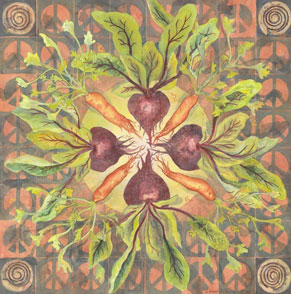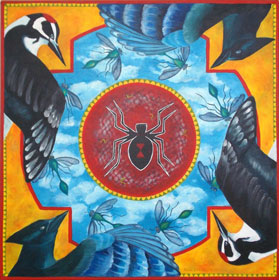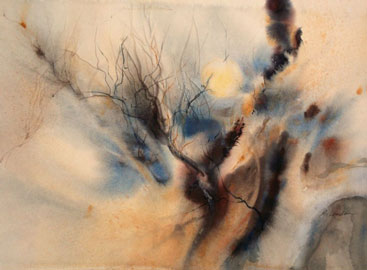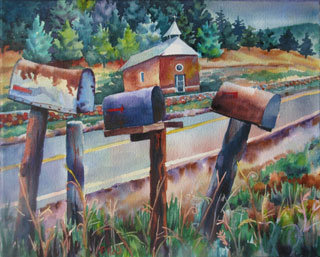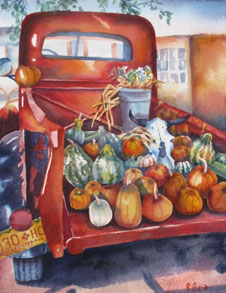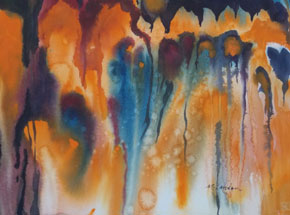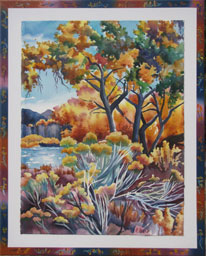A Taste of NM: Watercolors in the Northern Mountains
The following article was originally written for and published in the newsletter of the Northwest Watercolor Society (April/May, 2015, pp. 19-21) by High Road Artisan Board member, Donna Caulton. It is reprinted here with permission of the Watercolor Society.
By Donna J Caulton, NWWS Signature Member
New Mexico seems to draw artists who, once they have been here, can’t stay away. The attractions are many, but expansive sky and light, diversity in the natural landscape and a vibrant cultural mix surely top the charts. Watercolorists, when coming here, often change their primary medium, as I did, to make the shift required to accommodate all this “brightness.”
Note, for instance, the differences between a watercolor I made during my final year in Seattle, “Mandala for Peace” and an acrylic painting I made during my first year in New Mexico, “Natural Order” the first in a series I call Mandalas of the Natural Order.
These two paintings are structurally the same and the palette is made up of the primary triad: red, blue and yellow. The two biggest differences I see are in the intensity of color and the stronger sense of place in the New Mexico piece. “Mandala for Peace” is a metaphor; feed the world to gain world peace, and could have been painted anywhere. The New Mexico piece is far more direct and specifically immediate, reflective of the strong visual environment. It says, “Hey, look at the life cycle going on in my own back yard.”
For the purposes of this article I have chosen two painters who now live in Northern New Mexico, but who migrated from other parts of the country. Unlike me, they both retained strong watercolor voices after coming to these mountains. Both artists clearly demonstrate two key qualities in their newer works, intensity of color and a sense of place, that help label them as “Southwest artists” and, indeed, as artistic voices separate from their previous environments and from the rest of the US.
When Nancy McLendon moved from east Texas to New Mexico, she was influenced by an article in New Mexico Magazine about the High Road to Taos (where she now lives in the village of Penasco) and Spanish Colonial Villages. Nancy clearly states how the strong sense of place here translates into her work. “…although marvelous to get to know many of the things that attracted me here, it was not the people, nor their adobe buildings, sacred rituals, time-honed skills of wood carving and pottery-making that I wanted to paint. It was the lack of interference with the land that allowed me to spend hours of intimacy with the ‘rocks and roots’ I had always professed to love and preferred to paint.” And in greater depth, “….public lands provided a wonderland of moss-covered stones, unexpected springs and creeks, flowing rivers, arroyos and timeless pleats in the foothills of the lower Rockies. I’d never dreamed I’d be foot-to-earth in this immense version of the scarce little valleys and viny havens I’d found in east Texas.”
It easy to see how Nancy’s love of subject matter carried over into her new environment and what happened to the expression of that in New Mexico’s brilliant light. The two pieces shown here both depict those microcosms of rocks and roots Nancy loves to paint. In the misty light of east Texas, as shown in the painting “Dance with the Moon,” the world is more diffuse. The mistiness even disguises whether this scene occurs during day or evening. A piece with very similar subject matter, “Red Mystery” in New Mexico’s bright light and colorful landforms, clearly says, “I really want to be seen; notice me.”
Paula Reid, an Espanola, New Mexico artist, was drawn here by similar attractions as was Nancy. Her work, although still done with watercolors, changed immediately in every other way imaginable. “In New Mexico I am captivated by the traditional Hispanic and Native American life ways, so I paint the everyday scenes and villages here…..in Ohio it never occurred to me to paint landscapes, but in New Mexico, everywhere one looks there is a gorgeous painting.”
These two paintings are some of Paula’s New Mexico works. Although Paula has no documented work for comparison from her painting days in Ohio, her words tell all: “My subject matter (in Ohio) was all over the place, but not many scenes from life. When I painted realism, I painted true and ho-hum colors.”
Although many watercolorists paint scenes from county life, there is nothing about the colors in Paula’s or Nancy’s present work that could ever be described as “ho-hum.” Many who have never spent time in New Mexico see Southwest art in general as garish or exaggerated in color intensity. As with much artwork, the intensity of color is a reflection of the light in the natural surroundings. And this light and the vastness and clarity of space in which to see it, are the two things that contribute most strongly to these regional characteristics.
And what is it about the light? Ask Paula. She professes not to know, but read on. “There have been scientific attempts to explain the factors like altitude plus latitude plus whatever. All I know is that there is a warmer, golden, sometimes pinkish light here that not only feels wonderful to be in, but that enlivens the already colorful and deeply formed landscape all year long. Even a cloudy day is special.”
Does Nancy see this natural drama in the same way? Well, not quite. “There is a freedom of dancing with paint and lively color since I moved to New Mexico. The light at these altitudes of 5,000 to 12,000 feet creates incredible contrasts on the dips and surges of the land. It is entirely possible to use a faint glaze and the deepest saturation of dark hues side by side with absolute credulity. Vibrant colors can step lively or even stomp through a painting, creating the spirit of Pueblo feast days, holy processions, wedding dances, hay-hauling trucks, shouts from horseback and men with sticks moving cattle from summer to winter and back.”
If you are under the illusion that these artists must go out seeking subject matter for their work, that would be an erroneous assumption. We are not considering, in this article, all of the Southwest. In the mountains of North-central New Mexico, time has stood still in many ways. Here at the foot of the Sangre de Cristo Mountains, the southernmost chain of the Rockies, much of what we see in the everyday has been just that way for hundreds of years. The majority of the cultural presence is Native American and Spanish. The mountains, of course, dominate the landscape, the sky is omnipresent, and the adobe architecture brings land forms, people and handiwork together as one. Those happenings that Nancy speaks of in relation to vibrant colors are not the unusual; they are the everyday norm. Any artist who has spent extended time in this area absorbs this world, finding a place in the natural rhythms of time gone from so much of our greater culture. Paula, in describing her art process, takes strong notice of the way this timelessness has settled into her nature: “the beauty of it here, and the color and patterns of the local traditional folk art, bring out the medievalist in me. What a happy discovery!”
Just before moving to New Mexico I recall expressing to myself and others, “I am NOT going to be one of those New Mexico painters who paint everything in blue and orange!” Well it turned out that three of the first four paintings I painted after moving here used just that palette. The sky, the most prevalent feature of our world, is often referred to as a “turquoise sky.” It is contrasted by the land and architectural forms which are dominated by orange/red/sienna hues. Because the natural expanse is so unobstructed and huge, it is nearly impossible to avoid responding to it when painting. And why would one wish to do such a thing?
It is also true that Nancy McLendon’s watercolors, at times, take on that orange/blue opposition. In this painting, called “Vigil,” Nancy’s expression of rocks and roots, for example, is completely characteristic of her signature way of working
which she describes as “wet, color saturated, loose yet controlled, pointedly organic, abstract.” It is also painted primarily in blue and orange. She describes a strong relationship with her subject matter in this way: “I spend time examining the intricate patterns and colors of rocks, moss, lichen, the knots and twists of limb or root. I use my senses to intimately experience my subject. I rely on my memory of ‘intimately being with my subject’ to guide my painting.”
If you take a good look at Paula’s work, drawn mostly from the scenic world around her, you will find blue and orange make up the essential palette of nearly every piece. That color choice, however, is more evident in some work than others, as in this piece called, “On the Chama near Abiquiu.”
Paula describes her signature way of working as “half wet, half dry, foreground to background. I rely on the merging of colors and lights and darks.” There are other things, however, that lead one to recognize “Paula” in her work. Unlike many artists, she does not take herself too seriously. “Color is so playful. Some words that come to mind about my work are color, busy-ness, and decorativeness.”
Generally artists don’t refer to their work as decorative. Paula, however, in an entirely professional and thought-out manner, uses acrylic paint to create the frames that house many of her watercolor paintings, matching them to the color schemes and sensibilities of the paintings.
Can a painter make paintings anywhere? Well, of course. Are some New Mexico watercolors difficult to differentiate from paintings painted elsewhere? Again, of course they are. All New Mexico paintings are not as characteristically different as those of the painters chosen for this article. The fact that these painters moved from elsewhere, though, and indeed did have their work change after coming here is telltale of the strong influence of region on imagery. It is the painters who interact with the world, light and surround in which they live. Generally artists are not here, however, by happenstance.
The sense of place is so strong in this particular work because it is the place that drew the artists here to begin with. Nancy McLendon states it so beautifully in these few short words: “Many paintings done in New Mexico visually portray New Mexico. I think my paintings may have a sense of the universal, but I could have painted them only in New Mexico.” And that really says it all.
BRIEFEST OF BIOS:
NANCY McLENDON
Nancy spent much of her adult life teaching in the public schools as well as teaching watercolor classes privately.
She says of her teaching style: “I teach basic techniques of traditional aquarelle and design. I teach what I think is essential for any watercolorist to know before he/she is able to innovate and create, experiment.”
She also is owner of Walking Woman Gallery in Penasco, NM, where she displays her work and that of several local artists. Nancy also shares some of her writing on her blog, joyjoy13.blogspot.com.
PAULA REID
Paula has been a teacher of remedial reading at Northern New Mexico College in Espanola. She paints in her home studio.
Her first two years of Fine Art studies were at Ohio University (1967-69). She completed her BA at the College of Santa Fe in 1985. Paula also worked extensively with a group of local painters who were for a time under the tutelage of Jan Hart (see HotPress, Jul/Aug2014).
Paula has resided in New Mexico since the 70’s. She also loves to travel, “I would need several lifetimes to paint all of what this earth and its peoples have created”. (http://www.paulareidarts.com/about.html).
